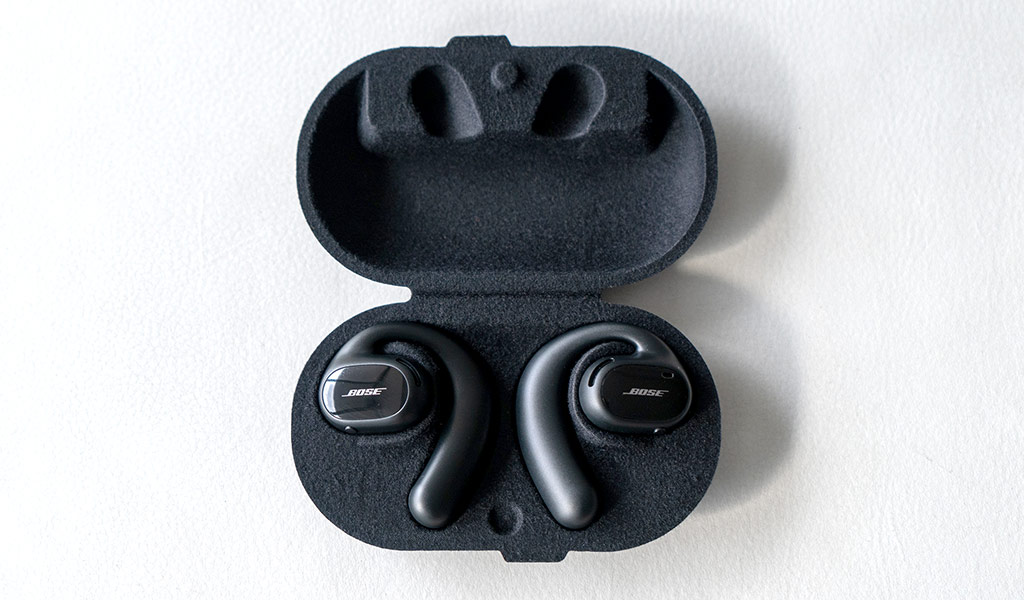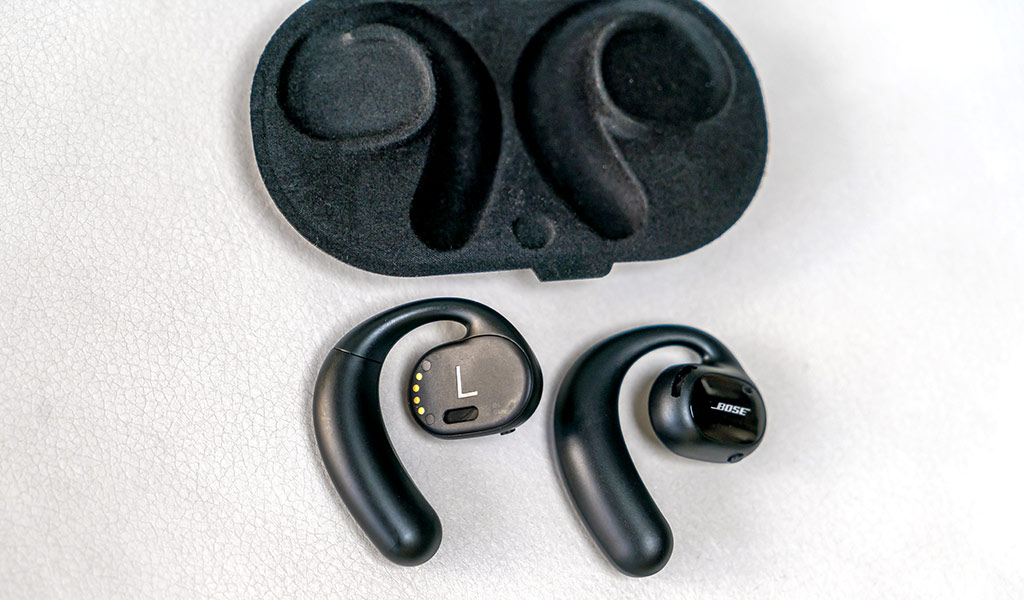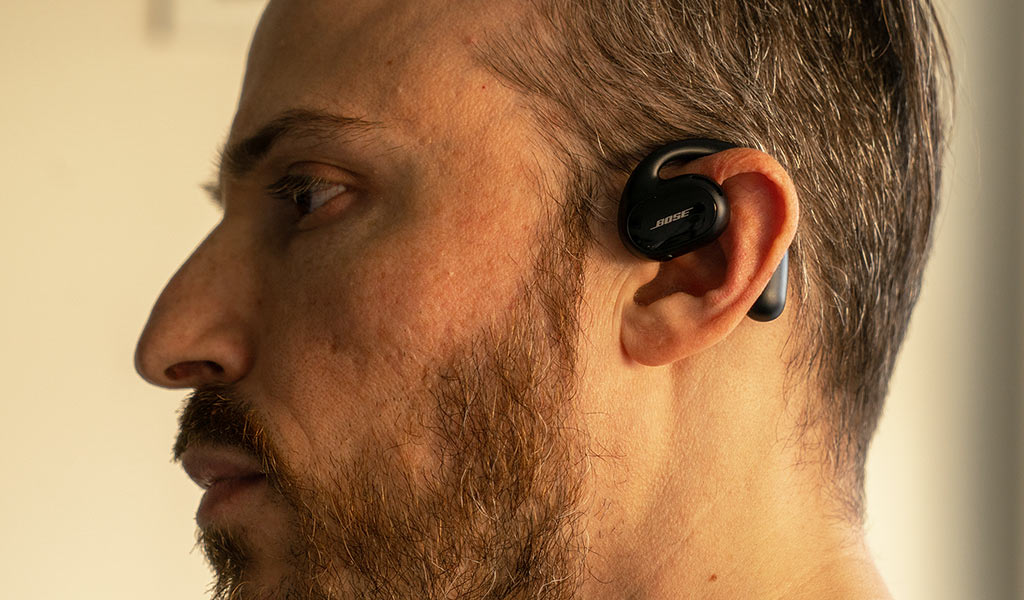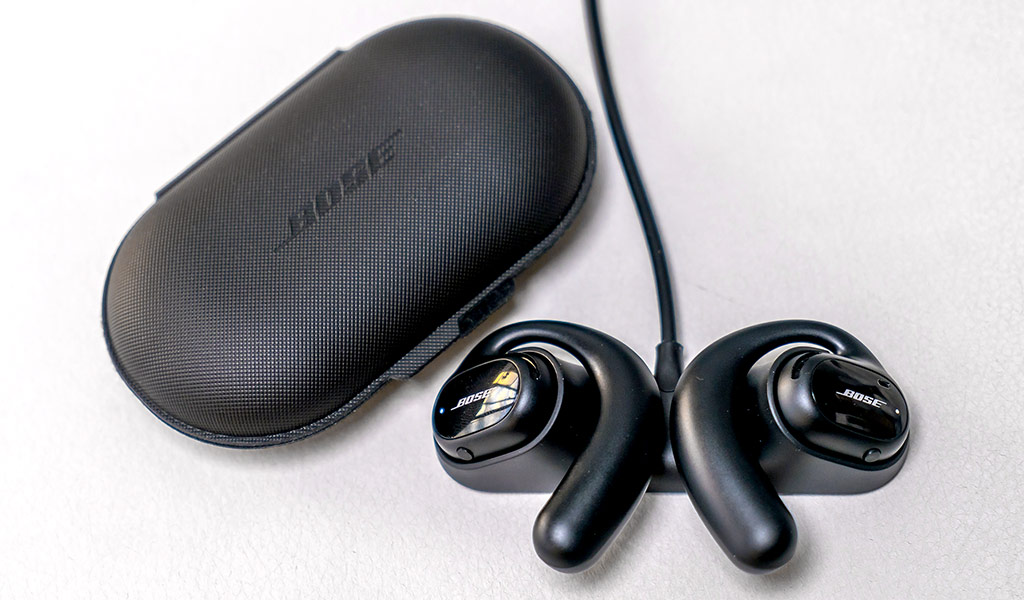
For Bose, the Sport Open Earbuds bring the company’s audio prowess to an unusual design that tries to achieve a functional breakthrough. Anytime a company comes up with a uniquely different look for a pair of earbuds, it’s worth taking notice.
The Sport Open Earbuds are not “earbuds” in the truest sense, meaning they don’t actually burrow into your ear canal. Indeed, there’s little to no contact with the inner ear at all, as the main purpose is to keep your ears free to hear ambient sound. But they certainly are truly wireless, as so many other earbuds are nowadays, and the unfettered fit caters to the active crowd.
Sport Open Earbuds design and comfort
Don’t confuse these earbuds with the Bose Sport Earbuds, which are totally different designs. Nor are they like the Bose QuietComfort Earbuds that aren’t necessarily sporty, but offer some of the best noise-cancellation available. These are a compromise in that you don’t get to block out the outside world, but you still get to hear the music with better quality.
At first, you might wonder how that’s possible based on the design. The speakers suspend over the ear from loops that are far from adjustable. The composite material is durable, except with very little give when it comes to comfort, so you have to roll with what’s here. Bose made the ear loops thicker at the base, and thinner at the point of contact with the speakers to contour to the space behind one’s ear.

Bose’s photos indicate a pretty steady and symmetrical fit though I think your own experience will vary. Without a way to adjust how the loops fit, the speakers will land wherever they land. Thankfully, it built these with enough leeway to fit most ears out of the box, so it shouldn’t be an issue—at least not right away.
These are very much a one-size-fits-all pair, with zero ability to shift how they fit or feel once you wear them. I can’t even point to minor adjustments that might work. Based on my own experience, they were probably made for shorter periods. Rather than wearing them throughout a full day, you might just stick to only while you’re active.
For example, I wore them throughout a full day at home listening to podcasts while doing chores, or taking phone calls hands-free. At first, they were fine, but the pressure from the loops did eventually lead to some aches necessitating me putting them back in their case.

Setup and technology inside
The Sport Open Earbuds use Bose’s OpenAudio technology, which is different from bone conduction. Bone conduction headphones take the eardrums out of the equation by generating soundwaves through the jawbones that the inner ear picks up to let you hear them.
OpenAudio does it the old-fashioned way by using airwaves to push the sound from the earbuds to the inner ear. The key is to do it in such a way that reduces how much audio ‘bleed’ there is to the outside. Basically, these should play moderately loud without someone nearby being able to hear the audio coming out of them.

Being Bluetooth-enabled, the easiest way to pair them is to use the Bose Music app on iOS or Android. The app is pretty straightforward, though bereft of features that would’ve been useful. There is no equalizer to manually adjust audio, and you won’t find much else beyond that. You can learn the onboard controls amongst a few other things. The Shortcut section is only one feature, which is to press the physical button on the left earbud to hear the battery level. That’s it. Bose makes it seem like there are options to choose from, but as of now, that’s the only one.
Press the button once on the right earbud to play/pause audio. Double-click to skip a track, or triple-click to repeat it. A single press also answers or ends a phone call, whereas a double-click will decline a call. Press and hold the left earbud button to bring up the phone’s onboard voice assistant.

Audio performance
The Sport Open Earbuds do sound better than you might think their design manages. There’s a depth and resonance that surprised me at first, and impressed me later on. At certain volumes, especially in quieter environments, it’s almost as if the earbuds are right on your ears, except for one distinct difference: bass.
Because there’s no seal in the ear canal, plus that distance from the earbud to the ear, you lose out on some of the bass, which impacts music genres that need it. Overall sound quality is definitely better than bone conduction headphones, and I did like the Sport Open more than the Bose Frames Tempo I reviewed as well.
However, I did notice they had to tangle with outside noises when other things were going on. Part of that is by design because the concept is for you to hear your surroundings without having to mute or take the earbuds off. For runners, walkers or bike riders outdoors, that’s important for safety reasons. Under those conditions, you’ll probably have to raise the volume, which in turn, means those close enough to you will hear what you’re playing.
I found the same was true of phone calls. While I could hold a conversation with someone indoors, there was always a chance some of the caller’s voice would seep out. Outdoors, ambient noises would seep in. I also wasn’t as impressed with the onboard microphones’ ability to amplify my voice. The Frames Tempo were better at that, and I’m hoping Bose improves on it here through a future firmware update.
Bose built these earbuds with an IPX4 rating for water and sweat resistance. Not bad, but hardly what I would consider really durable, so if you do plan to break a sweat, make sure to wipe them clean after.

Battery life
There’s one major design point to think about here and that’s how the Sport Open Earbuds charge. Bose includes a nice case for them, but it’s just a carrying case for storage. There’s no battery inside, so when you want to charge them, you have to use the included charging dock instead. They attach magnetically, so it’s easy enough to use, but it adds an extra item to the whole product. True wireless earbuds generally charge inside their cases, so these are definitely outliers.
Did Bose do it to make the case smaller? I’m not sure, but in any case, it rates these earbuds at eight hours per charge at default volume. Based on higher volume levels, I’d say you’re looking at more like six hours and change, depending on how high you go. They do charge back up relatively quickly, taking about an hour to go from empty to full.
Final thoughts
I mentioned comfort earlier, and that does matter when talking about a product that offers no way to effectuate change in how they fit. How you feel after wearing them for a while is also beyond your control. On top of that, it’s a case of what you hear is what you get. For me, the most discomfort came from the thicker portion of the loop, but you may not experience the same thing. Or maybe you’ll find they pinch in another part of your ear.
That kind of mystery is inherent in the Bose Sport Open Earbuds because they aren’t made with customization in mind. They’re clearly best for more active users who want to hear the background, or even listeners who don’t like sticking something in their ears. Either way, they do sound better than you’d expect, provided you’re cool with losing out on some bass.
The Bose Sport Open Earbuds are available now.




I prefer the hook design to the basic bud design. I have a pair similar to these but from another manufacturer and I have to say the hook and lack of wire between the ears makes it much more secure.
It certainly does, except in this case, the lack of flexibility in the hooks plays a big role in the level of comfort. It’s the main reason why it’s hard for me to qualify who they would fit best.
This is not a want. This is a need
Comments are closed.